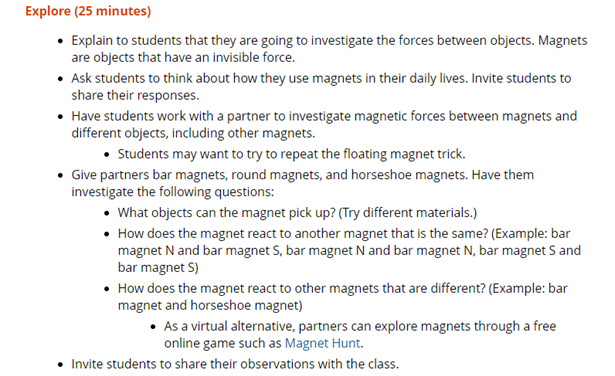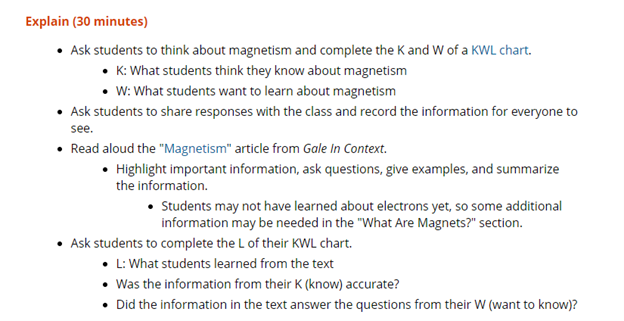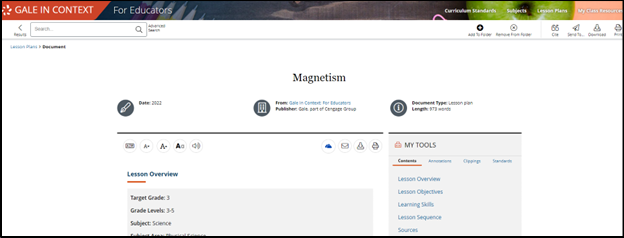| By Stacey Zusy |
In an age of evolving technology, shrinking attention spans, and increasing pressures on educators, engaging students in learning is becoming more of a challenge.
How can teachers motivate their students to develop an interest in new concepts and a desire to learn? Try creating lessons using the 5E instructional model.
Popular in STEM classes, the 5E model focuses on engaging students in the classroom to help them build knowledge through phased lessons. This model is characterized by inquiry-based learning. Using inquiry as a teaching method encourages students to discover information themselves instead of having it dictated to them.1 At its core, the 5E model motivates student engagement by making them active participants in their learning.
Why Does the 5E Model Work?
In 1962, educators J. Myron Atkin and Robert Karplus determined the key elements of an effective learning cycle: exploration, term introduction, and concept application. Although guided by an instructor to ensure key concepts are understood, the ideal cycle provides learners with more opportunities to take control of their learning experiences.2
The 5E model establishes an easy-to-follow instructional framework for teachers to apply this learning cycle in classroom lessons. As a phased approach, the model enables teachers to introduce, engage, and analyze student learning across any topic, subject, and grade level.
What Are the 5 Phases?
Rodger Bybee, co-creator of the model, explains, “The 5E Model of Instruction includes five phases: Engage, Explore, Explain, Elaborate, and Evaluate. It provides a carefully planned sequence of instruction that places students at the center of learning.”3
To demonstrate the 5E model in action, let’s walk through each phase and consider examples from a science lesson on magnetism* from Gale In Context: For Educators.
*Current Gale In Context: For Educators can access the lesson plan here.
1. Engage
The first phase of the 5E model is used to introduce students to the topic, gauge their current understanding, and spark curiosity for more engaged learning. Educators should ask open-ended questions and facilitate discussions about the concepts they plan to cover.
For example, in the magnetism lesson, the Engage phase introduces the concept to students with a magic trick using magnets. This activity is followed by a student-brainstorming session about how the trick worked.

Other examples of engaging activities are showing introductory videos, beginning KWL charts (just the K & W portions for phase one), or sharing related items to pique student curiosity in the lesson.
2. Explore
The second phase, and arguably the most important, has students Explore the new concept through concrete learning experiences. Plan hands-on activities that allow students to work together, investigate objects or situations, and make observations. In this phase, teachers can act as consultants to their students to prompt questions and direct personalized learning experiences. This should be the longest portion of the lesson, as it’s important to give students time to truly explore.
The magnetism lesson guides students through an investigation of magnets, allowing them to learn through inquiry.

3. Explain
The Explain phase encourages students to consider their exploration and build knowledge of the topic. First, educators ask students what they learned during the Explore phase and if they have any questions. Then, instructors share additional information students need to understand about the topic, like key terms and processes, allowing students to make connections between what they’ve experienced and the associated term or concept. Multimedia such as images and videos can help supplement the Explain phase and cement knowledge building in students.
In our example lesson, the Explain phase utilizes a KWL chart. Educators can have students reiterate the “K” and “W” sections by asking students what they know and what they want to learn about magnetism. To complete the Explain phase, educators guide students through the “L” section to demonstrate what they’ve learned from their Explore experience and from an article on magnetism.

4. Elaborate
Similar to the Explore phase, the Elaborate phase hands the learning experience back to the students to apply concepts and increase understanding. Teachers can assign hands-on projects like presentations and expect students to use the vocabulary and definitions covered in the Explain phase.
To further demonstrate concepts for the magnetism lesson, the Elaborate phase asks students to think critically about how magnets help them solve problems at home. To visualize this, students are asked to sketch a solution with a written explanation of the magnetic forces at work.

5. Evaluate
Essential to any instructional model is assessing whether students are grasping core concepts. The final phase is a period of reflection to determine learning outcomes. Educators can use formal or informal assessments like self-assessments, writing assessments, or exams to have students demonstrate their understanding.
Again, in our example magnetism lesson, an informal assessment is recommended using a Think, Pair, Share activity. This allows students to showcase their holistic understanding of the concept, and gives educators the opportunity to assess learning outcomes based on the students’ solutions and explanations.

Understanding the Effectiveness of the 5E Model
The 5E model gives both teachers and students an approachable framework for learning new concepts with hands-on activities. Several studies analyzing the model prove it’s “effective because students are provided with time, prompts, and several opportunities to deeply engage with the learning object in a way that promotes connections between what is known and what is meant to be learned.”4
According to Lesley University, “The 5E Model is most effective when students are encountering new concepts for the very first time because there is opportunity for a complete learning cycle.” Experts also agree that the 5E model should be planned into your instruction over time and “is best used in a unit of two to three weeks in which each phase is the basis for one or more distinct lessons.”5
Use the 5E Model to Motivate Your Learners
Ready to incorporate the 5E model into your curriculum? Provide teachers with instructional planning tools like Gale In Context: For Educators to give them the framework and content they need to build engaging lessons.
For Educators connects teachers to lesson plans structured around learning activities and centered on student inquiry.
In addition to pre-made lesson plans, subscribers have access to quality, interdisciplinary resources across grade levels, curation tools to build their own lessons, and collaboration features to share with colleagues. For Educators also equips teachers with an accessible student learning environment, the ability to annotate resources with notes and critical thinking questions, and the functionality to seamlessly share content with students through various learning management systems.
Interested to see how Gale In Context: For Educators can support instruction at your school? Visit the product page for more info or reach out to your education consultant for a demo.
Bibliography
- Duran, Lena, and Emilio Duran. “The 5E Instructional Model: A Learning Cycle Approach for Inquiry-Based Science Teaching.” The Science Education Review, v3 n2 p49–58 (2004): ED.gov. https://files.eric.ed.gov/fulltext/EJ1058007.pdf. Accessed January 23, 2023.
- “Empowering Students: The 5E Model Explained.” Lesley University: Lesley.edu. https://lesley.edu/article/empowering-students-the-5e-model-explained. Accessed January 20, 2023.
- “5E Model of Instruction.” San Diego County Office of Education: ngss.sdcoe.net. https://ngss.sdcoe.net/Evidence-Based-Practices/5E-Model-of-Instruction. Accessed January 20, 2023.
- Ruiz-Martín, Héctor, and Rodger W. Bybee. “The cognitive principles of learning underlying the 5E Model of Instruction.” International Journal of STEM Education 9, no. 1 (2022): NA. Gale In Context: Science. https://link.gale.com/apps/doc/A695675665/SCIC?u=gale&sid=bookmark-SCIC&xid=7861634a. Accessed January 23, 2023.
- “Empowering Students: The 5E Model Explained.”

About the Author
Stacey Zusy previously served as an elementary school teacher and the program coordinator of education, providing educational leadership and travel experiences to middle school students. Although she considers herself a lifelong learner, she most recently earned her M.Ed. in learning design & technology. As the senior product manager for Gale eBooks, Stacey currently works to ensure that students and educators have access to credible, high-interest nonfiction content. In addition to her passion for education, Stacey loves to read and spend time with her family.


